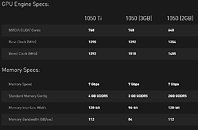- Joined
- Oct 9, 2007
- Messages
- 47,849 (7.39/day)
- Location
- Dublin, Ireland
| System Name | RBMK-1000 |
|---|---|
| Processor | AMD Ryzen 7 5700G |
| Motherboard | Gigabyte B550 AORUS Elite V2 |
| Cooling | DeepCool Gammax L240 V2 |
| Memory | 2x 16GB DDR4-3200 |
| Video Card(s) | Galax RTX 4070 Ti EX |
| Storage | Samsung 990 1TB |
| Display(s) | BenQ 1440p 60 Hz 27-inch |
| Case | Corsair Carbide 100R |
| Audio Device(s) | ASUS SupremeFX S1220A |
| Power Supply | Cooler Master MWE Gold 650W |
| Mouse | ASUS ROG Strix Impact |
| Keyboard | Gamdias Hermes E2 |
| Software | Windows 11 Pro |
NVIDIA's entry-level GeForce GTX 1050 launched in a new 3 GB variant, earlier this month, with 50 percent more memory than the 2 GB which the original GTX 1050 launched with. But there's a major catch that's relegated to the fine-print of the card's specifications on NVIDIA website, and something most NVIDIA AIC (add-in-card) partners won't particularly blare on their product packaging anywhere near as loudly as the memory amount, and that's memory bus width. The 3 GB GTX 1050 has 50 percent more memory than the original GTX 1050, but a 25% narrower memory bus, at just 96-bit.
When you look at a GTX 1050 3 GB graphics card PCB, you'll likely only find three 8 Gb (1 GB) memory chips, with one set of memory chip traces blanked out. It's not even like NVIDIA compensated for the narrower memory bus with higher memory clocks. The chips run at the same 7 Gbps as the original's, yielding just 84 GB/s memory bandwidth, compared to the original's 112 GB/s. The CUDA core count of the GTX 1050 3 GB is the same as the GTX 1050 Ti, with 768 CUDA cores, which twitch their thumbs as data is moved between the GPU and memory over Pony Express. Besides more CUDA cores, the GPU clocks are marginally higher, with 1392 MHz base and 1518 MHz GPU Boost, compared to 1354/1455 MHz of the original. NVIDIA, which recently sermonized the industry on "making products easier for consumers to identify" with its stillborn GPP, is once again caught concealing a major specification. To find it, you'll need to visit the product page of the GTX 1050, scroll all the way down to the specs sheet, and click on "view full specs" to reveal the memory bus width.

View at TechPowerUp Main Site
When you look at a GTX 1050 3 GB graphics card PCB, you'll likely only find three 8 Gb (1 GB) memory chips, with one set of memory chip traces blanked out. It's not even like NVIDIA compensated for the narrower memory bus with higher memory clocks. The chips run at the same 7 Gbps as the original's, yielding just 84 GB/s memory bandwidth, compared to the original's 112 GB/s. The CUDA core count of the GTX 1050 3 GB is the same as the GTX 1050 Ti, with 768 CUDA cores, which twitch their thumbs as data is moved between the GPU and memory over Pony Express. Besides more CUDA cores, the GPU clocks are marginally higher, with 1392 MHz base and 1518 MHz GPU Boost, compared to 1354/1455 MHz of the original. NVIDIA, which recently sermonized the industry on "making products easier for consumers to identify" with its stillborn GPP, is once again caught concealing a major specification. To find it, you'll need to visit the product page of the GTX 1050, scroll all the way down to the specs sheet, and click on "view full specs" to reveal the memory bus width.

View at TechPowerUp Main Site






